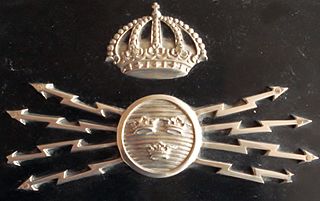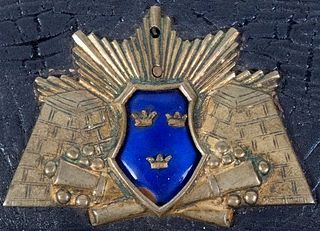An army division or division was during the 1900s in the Swedish Army a designation for a larger military unit, comprising two or more brigades, an artillery regiment, an engineer battalion, an anti-aircraft battalion, a signal battalion and a transport battalion. An arméfördelning corresponds to a division in many countries' armies, and it has been common to also use the word "division" in Swedish when referring to foreign rather than Swedish military units. The last divisions were disbanded through the Defence Act of 2000 and were replaced between 2000 and 2004 as a transition period of the 1st Mechanized Division.

Major General Karl Albert Byron Amundson (KABA) was a Swedish Air Force officer, ballooner and military attaché. He was the first Swedish Chief of the Air Force (1926–31).

Field Telegraph Corps, designation Ing 3, was a Swedish engineering unit within the Swedish Armed Forces which served in various forms between 1902 and 1937. The main part of the unit was located in the Stockholm Garrison in Stockholm, Uppland.
The Royal Swedish Naval Staff College was a Swedish Navy training establishment between 1898 and 1961, providing courses for naval officers. It was the home of the Swedish Navy's staff college, which provided advanced training for officers. It was located within the Stockholm garrison in Stockholm, Sweden.
The Royal Swedish Army Staff College was a Swedish Army training establishment between 1866 and 1961, providing courses for army officers. It was the home of the Swedish Army's staff college, which provided advanced training for officers. It was located within the Stockholm Garrison in Stockholm, Sweden.

Artillery and Engineering College was a Swedish Army training establishment active between 1878 and 1992, providing courses for artillery officers. It was located within the Stockholm Garrison in Stockholm, Sweden.
Karlskrona Artillery Corps was a coastal artillery unit of the Swedish Navy which operated between 1893 and 1902. The unit was based in Karlskrona in Blekinge.

The Surgeon-General of the Swedish Armed Forces is the highest-ranking medical officer of the Swedish Armed Forces. The Surgeon-General is responsible for the supervision of the Swedish Armed Forces, the Defence Materiel Administration, the Swedish Fortifications Agency and the National Defence Radio Establishment. This includes supervision in the areas of environment, health, nature, sewage, waste and chemicals.

The Vaxholm Artillery Corps was a corps-level artillery formation of the Swedish Army which operated between 1889 and 1901. The unit was based in Vaxholm in Uppland.
Vaxholm Grenadier Regiment, also I 26, was a Swedish Army infantry regiment that was active in various forms 1902–1927. The unit was based on Rindö in Vaxholm.
The Master-General of the Ordnance was the title of a senior military official who was an artillery general and at times head of the Royal Swedish Army Materiel Administration's Artillery Department and artillery inspector. The Master-General of the Ordnance held a pivotal role from the 17th to the late 19th century, overseeing artillery administration, procurement, and maintenance. Originally known as the Riksfälttygsmästare, this position evolved to manage the Artillery Office and later the Ordnance Department of the Royal Swedish Army Materiel Administration. Until 1898, the Master-General also supervised the Swedish Artillery, but organizational changes then placed artillery units under division chiefs, while the Master-General retained authority over key artillery functions. Responsibilities included inspecting artillery exercises and overseeing weapon development, production, and equipment maintenance. The role was eventually split into separate appointments in 1937, with the Master-General heading the Swedish Army Ordnance Corps until its dissolution in 1968.
The Swedish Army Veterinary Corps was an administrative corps for veterinarians of the Swedish Army from 1887 to 1969. Its task was, in peace as well as in war, to provide army units etcetera with especially trained staff for veterinary positions in the army.
Underlöjtnant was the lowest officer rank in the Swedish Army from 1835 to 1937 instead of the previous ranks of fänrik and cornet. Fänrik was reintroduced in 1914 with the same position as underlöjtnant, from 1926 with lower position.
The Swedish Naval Medical Officers’ Corps was an administrative corps established in 1902 for military physicians in the Swedish Navy and in the Swedish Coastal Artillery. The corps was amalgamated into the Medical Corps of the Swedish Armed Forces in 1969.
Karlsborg Artillery Regiment, designation A 9, was a Swedish Army artillery unit which operated between 1920 and 1937. The unit was based in Karlsborg Garrison in Karlsborg, Sweden.
Life Guards of Horse was a Swedish Army cavalry regiment, first raised in 1770. It saw service for two centuries, before being amalgamated with the Life Regiment Dragoons to form the Life Regiment of Horse in 1928.
Rear admiral (RAdm) (Swedish: Konteramiral, Kam) is a two-star commissioned naval officer rank in the Swedish Navy. Rear admiral ranks above rear admiral (lower half) and below vice admiral. Rear admiral is equivalent to the rank of major general.

General Gustaf Fredrik Oskar Uggla was a senior Swedish Army officer. Uggla had a distinguished military career in Sweden during the late 19th and early 20th centuries. Commissioned in 1863, he rose through the ranks, serving in various capacities, including as a teacher at the Royal Military Academy and as a military attaché in Vienna. Uggla's career highlights include commanding the Royal Military Academy and later the 2nd Army Division. He retired as a general in 1913 but continued contributing to military committees.
Flag captain was in the Swedish Navy a captain or commander who served as deputy to a fleet commander. During the 1900s, the flag captain served as chief of staff of Flaggen, the staff of the Chief of the Coastal Fleet.
The Marine Regiment was a naval artillery unit within the Swedish Navy that operated from 1824 to 1886. The unit was created in 1845 from the former Naval Artillery Regiment and was intended for garrison and guard duty at naval stations and fortifications, as well as for landing operations on ships. In 1871, the Marine Regiment was put on the list for disbandment but was revived again when it was transferred to the army as part of the Blekinge Battalion in 1886.






